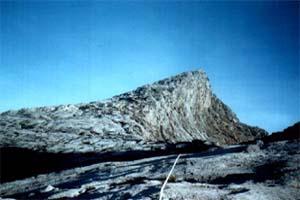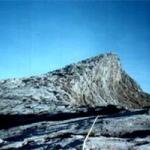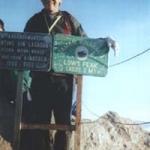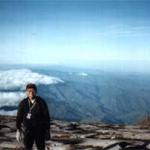Sabah's Kinabalu Park, a UNESCO World Heritage Site
It was indeed a piece of good news for Malaysians who are lovers of Planet Earth when Kinabalu Park was inscribed in UNESCO's World Heritage List in December 2000. Inscription on this List confirms the exceptional universal value of a natural or cultural site which deserves protection for the benefit of all humanity.
To naturalists, nature lovers, botanists, biologists, bird watchers, trekkers, mountain climbers and the ordinary you and me, images of Kinabalu Park and its crown jewel, Mount Kinabalu evoke much awe and amour. In the eyes of many, the Park is an indelible and established brand for Sabah just as the Serengeti National Park epitomizes Tanzania.
Geography and Climate
The Park is situated in the East Malaysian state of Sabah (British North Borneo before September 1963). Sabah lies on the north eastern part of the island of Borneo. It stretches through the entire west coast of Sabah with its highest peak Mount Kinabalu visible from the South China Sea even though it is many miles inland. Mount Kinabalu's massive structure dwarfs everything around it. The Kinabalu Park itself covers an area of 750 square kilometers (300 square miles). Mount Kinabalu at 4101 meters (13455 feet) is the highest mountain between the majestic peaks of the Himalayas and the mountains in the 2500-kilometer long Penunungan Maoke or Central Range in West Papua (formerly known as Irian Jaya). It contains the snow-capped peaks of Mount Puncak Jaya (Carstensz Pyramid, 4884 meters/16020 feet), Puncak Mandala (Julianatop, 4640 meters/15219 feet) and Ngga Pilimsit (Idenburgtop, 4717 meters/15472 feet) as well as Puncak Trikora (Wilhelmina, 4730 meters/15514 feet) whose glaciers disappeared between 1939 and 1962).
In Sabah, Mount Kinabalu stands head and shoulders above all other Malaysian mountains with the next two highest peaks being Mount Trus Madi (2642 meters/8666 feet) and Mount Tambuyukon (2580 meters/8462 feet). They are located respectively 50 kilometers south and 20 kilometers north of Mount Kinabalu. Mount Tambuyukon lies within the boundaries of the Park. The lowest elevation in Kinabalu Park is at Poring Hot Springs (550 meters/1805 feet) which lies in the Park?s southern boundary. Therefore within the relatively small Park area the temperature decreases from 25° Celsius at sweltering and humid Poring to 4° C at cool and crisp Mount Kinabalu summit. This makes visiting the Park and conquering the summit of Mount Kinabalu akin to traveling from the equator to the Polar region during summer. What's more amazing is this can all be done within a day by foot!
The great variation in climatic conditions means that there is a myriad of vegetation and natural habitat and this in turn helps to increase in the number of species of flora and fauna. Professor E.J.H. Corner (1906 to 1996), an eminent Cambridge University botanist and who served as the Assistant Director of Singapore's Botanic Garden from 1929 to 1946, said that the Park "has the richest and most remarkable assemblage of plants in the world" ("Kinabalu-Summit of Borneo", edited by K.M. Wong & A. Phillipps).
Because of its high altitude, clouds are trapped in many parts of the Park and it enjoys heavy rainfall for several months of the year. Visitors must come prepared by arming themselves with raincoats or umbrellas at all times of the year. Dr Willem Meijer a botanist described Kinabalu as "a mountain of mist and rain". The swirling mists and puffy clouds constantly change the scenery and visages of Kinabalu yet its beauty endures. Tom Harrison who was curator of the Sarawak Museum from 1947 to 1967 wrote: "One hour it is there, the next nowhere-lost in the cloud world." Both he and his wife, Barbara, though not trained as archeologists, achieved fame by their diggings in the Niah Caves in Sarawak from 1954 to 1962. They found in 1958 the skull of a homo-sapiens or Modern Man who had lived 40000 years ago during the Paleolithic period. This is the oldest human fossil discovered in the island of Borneo.
Geology
Kinabalu comprises an oval-shaped granite dome formed when magma broke to the surface from the inner depths of the Earth's crust millions of years ago. The violent explosions formed the surrounding sedimentary shale and sandstones into the Crocker and Trus Madi mountain ranges. Geologically Kinabalu is a young mountain and it is said to be still rising but very slowly. About 100,000 years ago during the last ice age Kinabalu was enveloped by ice and glaciers which flowed down the slopes when the weather got hotter. The ice-cap is believed to have melted away a mere 3000 years ago. The glacial flow scoured the surface of the mountain and as a result in various parts of the summit the surface was as smooth as highways which are well-graded and paved.
The massive glaciers too traveled along a geological fault line and spilled into a chasm named Low's Gully which plunges from an elevation of 3900 meters (12800 feet) to depths exceeding 1800 meters (6000 feet). Low's Gully, the most spectacular feature of the mountain, split it into two arms forming the Western and Eastern Summit Plateau. The gully is more than 16 kilometers (10 miles) in length. Only a few sharp summit peaks stood out above the ice and they are bestowed with names such as Low's Peak, St. John's Peak, Ugly Sister Peak, Donkey's Ears and a few others named after British monarchs. Deep ravines crisscrossed the 10-square kilometer (4-square mile) summit area. On the bare rock surface at or near the summit I was puzzled by the presence of numerous slender bands or dykes hundreds of meters long. They looked like road markings. I found out that these dykes represent the last phase of intrusion of igneous rocks which had intruded through the older granite formation along fractures.
Legacy
Sabah is irredeemably indebted to Professor E.J.H. Corner who led two Royal Society of London expeditions in 1961 and 1964 to Kinabalu. Following the first expedition he wrote a report in 1961 entitled "The Proposed National Park of Kinabalu" and submitted it to the Governor of what was then the Crown Colony of North Borneo. The result was the enactment of the National Park Ordinance of 1962 by the colonial legislature. This in turn led to the formation of Kinabalu Park in 1964 a year after Sabah's independence through a merger with Malaya.
History of Ascent
Mt. Kinabalu's summit was first conquered by Colonial Secretary of British Labuan, Hugh Low (later Sir Hugh when he was British Resident in Perak state in British Malaya) in 1851. The native Dusuns who resided in the foothills of Kinabalu and the surrounding Crocker Range did not dare climb the mountain for fear of disturbing the resting place of the spirits of their departed ancestors. In the early years prior to each climbing expedition, the Dusuns who served as guides and porters would perform rituals and sacrifices to appease the spirits and to seek safe passage. Nowadays, the frequency of these sacrificial rituals has been reduced to once a year and the practices include the sacrifice of seven white chickens at the summit.
Hugh Low made two more ascents in 1858 with Spencer St. John, the British Consul in Brunei. Although Low reached the summit plateau he did not reach the highest peak that now bears his name. That honor belonged to John Whitehead a zoologist who discovered two of Kinabalu's most spectacular birds, Whitehead's Trogon and Whitehead's Broadbill which are endemic montane species. He climbed up the highest peak in 1888. The first woman to reach the summit was Lilian Gibbs, a British Museum botanist who had gone up the mountain in 1910. She was a prolific collector of plants and brought back to England about 1000 plants of which 87 proved new to science. At least nine species of plants of Kinabalu discovered by her were named in her honor and they comprise two palms, a flowering plant, a bamboo, an orchid, a ginger, a small herbaceous plant and two conifers. Of these the most fascinating plant is Miss Gibb's Lipstick Flower (Aeschynanthus gibbsiae) with bright colored corollas.
When the Park was first opened in 1964 the access was poor and climbing facilities were rudimentary. However when the road to the Park Headquarters from Kota Kinabalu, Sabah's capital was finally sealed in 1981 visitor arrivals jumped and the number of climbers shot up from 6045 in 1981 to 10378 the following year. Since 1994 the number of climbers has remained at around 30000 per annum
Natural Vegetation and Flora
Due to the wide range of altitude, from 550 meters (1805 feet) at Poring to 3960 meters (13000 feet) at the summit plateau, Kinabalu Park has essentially four main vegetation zones. Within each zone however there are localized variations depending on factors such as soil type, terrain, presence or absence of soils, proximity to streams and degree of exposure to sunlight. Kinabalu at altitudes above 1200 meters (4000 feet) is a meeting place for plants of Himalayan and Chinese genera and for plants of Australian and New Zealand and even American affinity. They consist of, among others, buttercups (of Australian affinity), the Rosaceous trees and shrubs and Violets (both of which are of Sino-Himalayan affinity) and they mingle with pitcher plants (Nepenthes) and bamboos of Bornean origins.
Lowland Dipterocarp Forest
Up to about 1200 meters (4000 feet), the tropical rain forests could be found. The dominant species is from the Dipterocarpaceae family which are mainly hardwoods exploited for the furniture, building and construction industries. The dipterocarps grow to heights of 50 meters (160 feet). They yield seeds which have two or more wing-like structures which help them disperse by wind action. Dipterocarps flower once in three or four years. However because of the diverse variety from the Dipterocarpeae family one can while walking in the Park observe at any time of the year trees in full bloom. Once every ten years or so most of the dipterocarps bloom all at once thus giving the entire forests a kaleidoscope of colors. This phenomenon is known as mega or mass flowering.
There is also a variety of wild fruit trees ranging from the commonly found rambutans, mangoes, durians and figs to the unusual taraps (Artocarpus odoratissimus) which is jackfruit-like and mawang (Mangifera pajang) which tastes like a mango. Common in the lowland forests are plants from the family of palms, gingers (Zingiberaceae family) and bamboos which are also found in the montane forests on higher elevations. Over 52 species of palms from 10 genera and 30 species of Zingiberaceae have been recorded within the confines of the Park. Six bamboo species are found within the Park and four just outside its limits. Many of the palms are climbers and their slender vines are covered with prickles which assist them in their quest to reach for sunlight.
These are the hardy rattans. The best known ginger is the torch ginger (Etlingera elatior) whose flower heads are commonly seen in farmer markets throughout Malaysia. Bamboos which have multiple uses exhibit a bewildering range of forms. Some are erect, others clambering to scrambling and still others are climbers.
Kinabalu Park has documented more than 608 species of ferns which figure exceeds the number of species found in the entire mainland Africa. Ferns are ubiquitous in all four climatic zones of the Park.
Being identified as a plant found in abundance in the wet and clammy tropics most of the fern species are found within the lowland forests. Ferns take various forms: There are tree ferns, shade ferns, thicket ferns, epiphytic ferns and tiny scrub ferns which are found in cracks and crevices in the summit plateau. On any walk at the Park one would not miss the nest ferns (Asplenium nidus) which are lodged in the forks of the trunks and branches of trees.
Orchids are perhaps the most loved plants because of their exquisite beauty, astounding variety and very wide distribution. John H. Beaman and Reed S. Beaman eminent botanists who had contributed much to the knowledge of Kinabalu flora estimated that there are more than 1000 species of orchids in 121 genera within the Park. Again, both epiphytic and terrestrial orchids are found at all altitudes of the Park. Perhaps the most enchanting orchid is one of the species of slipper orchid the Paphiopedium rothschildianum found only in Mt. Kinabalu. Its outstretched petals some 12 cm (4.5 inches) across look like the outspread arms of a native performing the Kadazan-Dusun sumazau dance.
Other magnificent orchids are those from the necklace orchid species (Coelogyne spp). Like necklaces, they dangle their long pendulous chains of flower with white sepals and petals from the branches of trees. When lovers of orchids think of Kinabalu Park, invariably, orchids come immediately to their mind. Unfortunately many of the wild species of orchids in the Park are getting rarer day-by-day as they are often poached for commercial reasons or stolen by or at the behest of orchid lovers.
The Rafflesia named after Sir Stamford Raffles who founded Singapore in 1819 is the largest flower in the plant kingdom. The genus Rafflesia consisting of 14 species are very rare tropical plants found in Borneo, Peninsular Malaysia, Thailand, Philippines, Java and Sumatra. Two species (R. keithii and R. Pricei) have been found in the Park in the Poring Hot Springs area. In recent years a third species, R. tengku-adlini was discovered near the Park in nearby eastern slopes of the Trus Madi Range. Surprising it was only not too long ago that the first Rafflesia was made known to the botanical world.
In 1818 Dr Joseph Arnold a surgeon and a naturalist visited Sumatra at the invitation of Sir Stamford then Lieutenant- Governor of Bencoolen (in Sumatra) a British East India Company protectorate. Dr. Arnold was shown the Rafflesia flower by a porter. This species of Rafflesia named R. arnoldii holds the record as the world's largest flower. The Rafflesia belongs to plants parasitic on wild forest vines. The only visible part of the plant is a single flower without leaves, stems or roots. The flowers of most of the species of Rafflesia emit an over- powering smell of a badly decaying carcass. While much had been written about its carrion-like odor which lasts only a few hours in time for it to attract flies and other pollinators while the bloom itself lasts three to four days. The buds however take nine months to a year to develop from a tiny knob covered with dark brown bracts on the stem of the host vines to the size of a large cabbage.
Lower Montane Forest
From about 1200 meters (4000 feet) to 2200 meters (7200 feet) the trees are shorter in stature. Deciduous trees of the temperate lands such as those from the family of oaks, chestnuts, myrtle, laurels, eucalyptus and the theaceae (tea) are found in this zone. There are also some conifers.
Kinabalu is the richest place in the world for the tropical pitcher plant, Nepenthes. Ten out of 36 species in Borneo are found in the Park. They are found mainly in the lower montane zone although some species are biased towards the upper montane forest. The most striking part of the pitcher plant is the colorful cup which although it appears as a part of the flower is actually a part of the leaf. The cup is used to trap insects for the plant to obtain nutrients. Insects visit the pitcher plant to collect nectar. Some insects enter into the cup but are unable to surmount the peristome or rim round the mouth of the pitcher. They cannot escape and eventually slither down the smooth internal sides of the pitcher and drown in the slimy digestive juices. The insects are digested and the water becomes a stinking soup from which the base of the pitcher plant absorbs the nourishment for their growth or survival.
The largest of the pitcher plant is the Nepenthes rajah. Way back in 1859 Botanist J.D. Hooker said: "This wonderful plant is certainly one of the most striking vegetable productions hitherto discovered and in this respect is worthy of taking place side by side with the Rafflesia arnoldii." Nepenthes endemic to Kinabalu are the N. burbidgeae, N. villosa and N. rajah.
Upper Montane Forest
This zone lies between 2200 meters above sea level to 3300 meters (11000 feet). The trees are stunted and their trunks and branches as well as leaves are draped with mosses and liverworts. Thick mists swirl and drift in tandem with the wind. Walking through the mossy forest, your clothes will be wet from water dripping from the trees.
I first thought that the rains are beginning to burst from the dark skies until my Dusun guide Lukie enlightened me on the symbiotic relationship between leaf foliage and the clouds. In this zone many species of rhododendrons predominate. Out of 50 species found in Borneo 24 grow in Kinabalu of which five are not found elsewhere. Rhododendrons thrive in places which are cool and moist. Most of their flowers are bell-shaped and each of the plants bears many flowers. Their colors are bright and are often red, scarlet, pink, yellow, orange and white. Their beautiful blooms stand out well in the mist-shrouded montane forests.
Sub-alpine Zone
The sub-alpine vegetation starts from 3300 meters (11000 feet) and reaches up to the summit. The trees are gnarled and grotesque. Conifers and rhododendrons are the most common plant species. Towards the higher end of the sub-alpine zone the stunted trees give way to herbaceous plants and grassy meadow-like vegetation dominates such as potentillas, buttercups, eyebrights and gentians. In some parts of the mountain, mosses, sedges, orchids and grasses take over the landscape which looks similar to the meadows commonly in temperate lands such as Switzerland.
In the summit plateau where the rock face is bare nothing grows except where a thin layer of soils accumulate cracks and crevices. In such nooks and corners hardy tiny mountain orchids and ferns found a root-hold. The tree line here is determined not by altitude but by whether soils are present. The fierce winds and the heavy torrential rains make it almost impossible for most of the plants to survive higher than 3700 meters (12200 feet) which is close to the summit.
Fauna
Most of Borneo's mammals live in the lowlands but some can be found in the lower montane forests of Kinabalu and a few stray beyond. The orang utans which is very much identified with Borneo have been sighted at elevations up to 1450 meters (4750 feet). Other primates of Borneo, the langurs, monkeys, Bornean gibbons, tarsiers and the slow lorises have often been observed in the Park except for the proboscis monkeys which are found only in the low lying swamp lands. There were no reported sightings of Borneo?s two most threatened mammals, the Asian wild cattle or banteng and the Sumatran rhinoceros which are extremely shy animals and they avoid the presence of people and human activity.
Visitors are unlikely to encounter the Asian wild elephants as they are found in the southern and eastern parts of Sabah. The other larger mammals recorded include the bearded pigs, sun bears, sambar deer, barking deer and mouse deer. The smaller mammals seen include the tree shrews, squirrels (tree, ground and flying squirrels), pangolins, porcupines while those likely to be spotted at night are the palm civets, Malay weasels, rats and mice, bats, flying foxes and the leopard cats. Kinabalu is also the home of a few species of mammals classified as insectivores which feed only or predominantly on invertebrates. They resemble rodents but they have rounded or conical teeth with sharp points unlike rodents chisel-like front teeth for gnawing.
Borneo's largest insectivore the moonrat has been recorded in the fringes of the Park while the Lesser Gymnure is confined to the areas of the Park above the lowland dipterocarp forests. The Black Shrew and the Kinabalu Shrew are found only on Mt. Kinabalu. The Ferret-badger is found at altitudes between 1100 meters (3600 feet) and 3000 meters (3300 feet). It has close relatives in the mountain ranges of mainland Asia and Java. However in Borneo it is confined to Mt. Kinabalu and nearby mountains. Kinabalu recorded more than 326 species of birds. The lowland birds are normally found below 1000 meters (3300 feet) while the sub-alpine zone birds forage for food at much higher altitudes including the summit plateau. The most common sub-alpine birds are the black and red Mountain Blackbird and the smaller dark olive-green Blackeye.
Other species of the sub-alpine forests include the little brown Sunda Bush- warbler and the Short-tailed Bush-warbler and they are often seen skulking about in the undergrowth above 2000 meters (6540 feet). Higher up above the tree line the Blue and White-browed Shortwing can often be sighted. Towards late afternoon when I was about to reach Laban Panar I was lucky enough to encounter a solitary Kinabalu Friendly Warbler which was hopping coyly along the well trodden trail a few feet in front of me. According to the 1970 Park Warden Annual Report this bird was "Not seen as often as in the past. A great number of climbers now walking the mountain trail have probably driven the birds to quieter areas." In 1888, John Whitehead had to shoo them away as they were frolicking near his feet. There are some 22 species of montane birds which include the Red-breasted partridge, Crimson-headed partridge, Everett's thrush and Kinabalu serpent eagle.
The Park has many species of butterflies and an even richer variety of moths which are not as conspicuous as the butterflies as many are tiny and are mostly only active at night. There are at least 40 species of frogs and toads recorded in Kinabalu and many more species of fresh water fishes, beetles, snakes and terrestrial mollusks (land snails and slugs).
* * * * *
Reference:
Kinabalu Park World Heritage Site.
* * * * *
 ThingsAsian
ThingsAsian



















